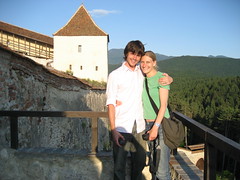Cows, carts and other rural things
After Budapest, we headed towards Romania. In the Hungarian countryside, we met the first person who genuinely thought that I (the passenger) was somehow driving the van without a steering wheel. He was, as you can imagine, extremely curious. He was also very excited to discover that the steering wheel was, in fact, on the other side of the vehicle to every other car he had ever seen.
Going into Romania was a big contrast to the rest of Eastern Europe. It may now be part of the EU (there are EU flags everywhere) and the cities may well be very cosmopolitan, but the border towns and the countryside are like stepping back in time. We had expected it a bit, but we were definitely surprised by the degree of change. At times the roads have been almost impassable (being little more than tracks and completely flooded, which isn’t great when you are on what is supposedly a major European trucking route).
The Lonely Planet bangs on about Romania being a land of castles, monasteries, skiing and stylish cities. In fact, it is mainly reams and reams of rural life: we have seen more horses and carts in the past few days than in the whole of the rest of our lives; chicken, turkeys and donkeys wander around the edge of the roads (and sometimes right down the middle of them - even on the major “E” roads we have had to slow down to overtake the occasional stray cow); there are enormous numbers of stray dogs – many alive, but many squashed at the side of the road as they seem to have no sense that the middle of the road is not the safest place to be. Absolutely all of the women in the countryside who are over the age of 40 wear headscarves. Many of the men wear hats, either caps or tall Romanian creations made of straw. The passing traffic on our trip through the mountains from Braşov heading north was about 30% vehicles and 70% ambling, sun-wrinkled women in headscarves; equally sun-wrinkled men in hats; horses and carts; and random animals.
We have seen some castles, though. Bran Castle (allegedly Count Dracula’s castle) wasn’t quite what we had hoped, mainly because it was overrun with screaming Romanian school children and really not all that dramatic. Worth a trip, though, if only for the enormous amounts of vampire related tat on sale. Just up the road, on the other hand, Râşnov Citadel was amazing. Our guide book told us nothing about it other than to mention that it exists and is a ruin. We struggled up a very steep slope, losing traction as we went. We arrived to find it closed, but for some reason the old Romanian gate keeper took a shine to us and let us in for a few minutes, though it turned out to be much longer and he didn’t seem to mind. We wandered around the tiny old town, up cobbled streets and past all the old houses. There is a 146m deep well dug by hand by two Turkish prisoners way back when, over a period of 17 years. They dug about 3cm a day over that time on the promise that they would be released once it was finished. There appears to be no record of whether they were released, but the well is huge and apparently kept the citadel going for hundreds of years. There is also a very old human skeleton partly visible in the ground – hopefully not the Turks; that’s not much of a way to thank them. The views from the citadel walls over the town below, the mountains and the enormous grassy plain below were amazing.
Although Transylvania is not quite what we expected, in that it is much flatter and less forested than we had though (and there are fewer grey stone castles perched on hills), some of the old towns are very pretty. Sighişoara is quite touristy, though, hence we met three men (two very tall, one very small with almost no teeth) dressed up in traditional garb (seemingly paid by the Council to promote tourism) who seemed to have “Welcome to Transylvania, Romania: thank you for visiting our Citadel” off pat in at least six languages (including Japanese) and shouted it very loudly every two minutes whilst banging a drum. Braşov is a lovely place to amble in the sunshine and seems to serve as a major wedding destination for all of the villages in Transylvania – the church just off the park had a conveyor belt system going and there was a queue of brides waiting to have their photos taken in front of each statue and fountain in the park.
After Braşov we headed north into Moldavia, which looked far more like the countryside we had expected in Transylvania: rolling hills, mountains, big open plains between the mountain ranges, and lots of villages strung along the road. It reminded Michael of the Hunza valley in Pakistan - very green; all local life focussed along the road; and lots of people sitting on benches outside their houses, chewing the fat and watching the world go by. It was a really picturesque and interesting drive through the mountains towards the Ukraine.


0 Comments:
Post a Comment
<< Home